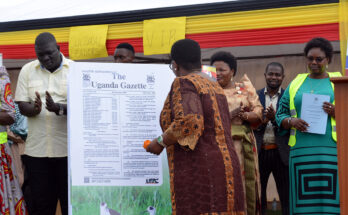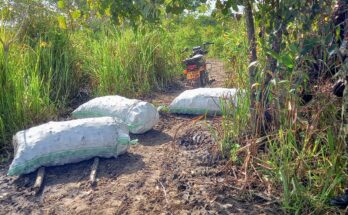Esther Amono, a mother of four children, moves around her house in her wheelchair. She has spinal muscular atrophy and cannot walk, so her family members help her.
Though the Northern region, which forms one-quarter of the country, lies outside the tropical belt and hence experiences only one rainy season, March to October. The situation worsened in the past two years with an adverse prolonged drought and sunshine heat with high temperatures. And that, says Amono, is making life tougher for people than the previous years.
“Getting to the market and other service delivery points quickly is a challenge,” Amono says of the growing challenge she faces in just getting basic needs. “Public transports don’t have shelters and far to get to – and accessible transport is not available in most cases.”
The combined disadvantageous effects from a lack of inclusive planning or early warning systems, less information and transportation options, and overall discriminatory attitudes have driven the global mortality rate for people with disabilities who experience natural disasters up to four times higher than it is for people without disabilities, according to a Lancet report.
Amono said during heavy rains “we cannot see the bumps on the roads or sidewalks, which make it riskier to drive our wheelchairs.”
Average temperatures in Uganda have increased by 1.3 degree Celsius since the 1960s. Notably, minimum temperatures have increased by 0.5–1.2°C. Increased average temperatures have been observed at 0.28°C per decade since 1960. Daily temperature observations since 1960 show significantly increasing trends in the frequency of the number of hot days, and much larger increased trends in the frequency of hot nights.
Hot days and nights are defined as the number of days/nights in which the temperature exceeded 10% of days/nights in the current climate of the region and season. Hot days in Uganda have increased by 74 days (an additional 20% of days) between 1960 and 2003.
Across Uganda, record temperatures have challenged daily lives, posing serious health risks to families, students, businesspeople and travellers. As with most other natural and manmade disasters, the people that suffer the most often are those that are the most marginalized.
“Indiscriminative illegal commercial charcoal businesses in Northern Uganda are the cause of all of the catastrophic events that we are experiencing, from prolonged drought to heavy rain downfall, flooding, and storm surges,” said Teddy Aciro Luwa, Chairperson of Gulu Women with Disabilities Union.
Persons with disabilities are frequently among the worst affected by climate change, similar to the disproportionately high rates of morbidity and mortality they suffer in emergencies while also being among the least able to get emergency assistance.
Certain conditions of disability are disproportionately affected by global warming. For example, people with spinal cord injuries cannot cool themselves during excessive heat while people with sclerosis feel more pain and fatigue during hot weather conditions.
“It feels that I am always living in a bubble. I am allergic to heat and cold and this makes me very vulnerable to climate change,” said Hellen Nyangoma, who struggles with rare chronic illnesses such as Ehlers-Danlos Syndrome, and Dysautonomia.
Some 15% of the world’s population have a disability, the World Bank reported. Many people with them also live in extreme poverty, exacerbating their vulnerability to climate change due to a general lack of proper sanitation, health care, nutrition or safe drinking water.
The plight of people with disabilities-their heightened exposure to risk and their struggle to respond and recover effectively-often dominates disaster narratives through the emergency and recovery phases.
Lack of mobility in emergencies is life-threatening
People with disabilities, women and children in South Asia and Africa are more vulnerable to severe weather events like heat waves, floods, cyclones and storm surges, according to experts.
This is because they have less access to information on climate adaptation, rarely benefit from government aid and have fewer economic privileges than men.

And extreme weather events like cyclones and floods are intensifying in a very short time, giving disabled people little time to move to safety, according to Kumari.
“People with disabilities, particularly with mobility issues, have limited capacity to respond to emergency situations during an extreme weather event,” she said.
But only 10% of people with disabilities believe their local governments have emergency, disaster management, or risk reduction plans that address their access and functional needs, according to a UN report. and just 20.6% said they could self-evacuate without difficulty in the event of a sudden disaster, a UN Office for Disaster Risk Reduction online survey found.
Interventions
In Northern Uganda, Lira district officials have embarked on tree and grass planting to trap emissions from growing city motor traffic and from their compost site where garbage is incinerated.
The government is also promoting the use of energy-saving technologies as a means of mitigating climate change effects in upcountry areas.
In Kasese District, Joseph Katswera, the Natural Resources Officer, has been emphasizing “tree growing.”
We are doing a lot of tree growing. People call it tree planting, but me, I prefer to call it tree growing because if you don’t follow up a plant, it will not grow,” he said.
The district has also embarked on sustainable soil and land management by constructing trenches, particularly in hilly areas, to reduce the speed of runoffs whenever it rains.
Kasese is the champion district in renewable energy use. Katswera has been rallying households to use energy saving stoves for cooking and solar lighting instead of clearing trees for wood fuel.
“Our homestead solar system coverage is now at 28.9%,” he said. In 2012, we were at 3%. I think we have made strides. Equally, we are at around 26.7 for the improved energy-saving stoves.”
Government taking charge
Uganda was the first African country to develop and endorse its Nationally Determined Contribution Partnership Plan (NDC-PP) in June 2018. It made key commitments in this regard, including, reducing national greenhouse gas emissions by 22% by 2030, reducing climate vulnerability of climate-sensitive resource-based, building climate resilience of key sectors and managing disaster risks.
Compared to other countries, Uganda ranks high in its number of commitments regarding climate change mitigation and environmental protection. The country launched its National Climate Change Policy in 2015, submitted Nationally Determined Contributions to the United Nations Framework Convention on Climate Change in 2018, has a Green Growth Strategy in place and has signed up to meet the Bonn Challenge.
Recently, local government officials participated in a training workshop supported by the World Bank, Uganda Country Office, in collaboration with the Climate Change Department in the Ministry of Water and Environment, Ministry of Finance and National Planning Authority.
The workshop brought together more than 30 planners, policymakers and key stakeholders for hands-on training that introduced them to the climate change and disaster risk screening tool. Joseph Isingoma, the Kasese District Senior Planner, said that budget tagging and climate risk assessment will be easier and more systematic with the tool in place.




